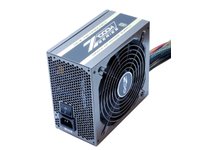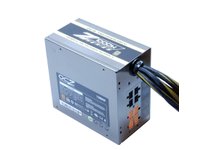Three 1000 W 80 PLUS Gold-Certified Power Supplies Tested
We received a trio of 1000 W power supplies priced between $200 and $300, so we ran them through our usual suite of tests to see if they really live up to their 80 PLUS Gold certifications. Surprisingly, all three hiccuped during efficiency testing.
OCZ Z-Series Z1000M
The OCZ Z-Series Z1000M is part of the manufacturer’s Maximum Performance category. Not wasting any time on modesty, OCZ describes the 1000 W PSU as the perfect power supply for enthusiasts who want nothing but the best. The five-year warranty and fairly lofty price of $205 underline the company's perceived quality standards. To be fair, the OCZ PSU is the least-expensive in our comparison here.
The Z1000M's performance is impressive on paper. Its single 12 V rail can handle up to 83 A, sufficient for extremely power-hungry computers. The maximum power on the 12 V rail is 1000 W, according to the manufacturer, the same number as the PSU’s specified continuous output. That means that if the 12 V rail is fully utilized, the OCZ Z1000M is actually delivering more than 1000 W.
The PSU has a very high-quality finish and its brushed surface makes it a feast for the eyes. The cables are partly modular, with the ATX, PCIe, and some of the SATA cables being hard-wired to the PSU. The length and number of cables is unusually generous, including six PCIe and 12 SATA connections, though perhaps we would have expected more than three Molex connectors from a PSU in this category.
| OCZ Z1000M | ||||||||
|---|---|---|---|---|---|---|---|---|
| AC Input | 100-240 V, 50-60 Hz | |||||||
| DC Output | +3.3 V | +5 V | +12 V (#1) | +12 V (#2) | +12 V (#3) | +12 V (#4) | -12 V | +5 Vsb |
| 25 A | 25 A | 83 A | n/a | n/a | n/a | 0.8 A | 6 A | |
| Individual Output | Row 3 - Cell 1 | Row 3 - Cell 2 | Row 3 - Cell 3 | Row 3 - Cell 4 | Row 3 - Cell 5 | 9.6 W | 30 W | |
| Rail Utilization | Sys | Sys | CPU & VGA | |||||
| Combined Output | 180 W | 1000 W | ||||||
| Total Continuous Output | 1000 W | |||||||
| Peak Output | 1100 W |





Get Tom's Hardware's best news and in-depth reviews, straight to your inbox.
Current page: OCZ Z-Series Z1000M
Prev Page Extreme Power For Extreme Users Next Page OCZ Z Series Z1000M: Measurements-
killbits hmm, maybe next time include a super-high-end psu that doesn't suck.Reply
http://www.newegg.com/Product/Product.aspx?Item=N82E16817139014
takes any of the psu's in this review to school. -
mr_cb7 Replyhmm, maybe next time include a super-high-end psu that doesn't suck.
Seriously where is PC Power & Cooling,Corsair, or Antec!
OCZ and Rosewill thats it? OCZ is alright, but Rosewill is crap.
try theses next time:
http://www.pcpower.com/power-supply/turbo-cool-1200.html (not GOLD I know but still)
http://www.newegg.ca/Product/Product.aspx?Item=N82E16817139014
http://www.ncix.com/products/?sku=56794&vpn=HCP-1200&manufacture=Antec -
one-shot I have a 750W Corsair PSU. When gaming with my i7 920 @ stock and SLI GTX 260s, I haven't come close to 400watts, according to my UPS. If you take the number the UPS gives and factor in the efficiency of the PSU, the power draw is much less. I've seen up to 360 watts with TF2 and Test Drive Unlimited 2 so far. Although running burn tests on GPUs and CPU will draw much more.Reply
Running Bionc on CPU and F@H on both GPUs, I draw 441 watts with ALL components under HEAVY load. That's 100% on all CPU threads and GPUs. 1000W is enough for a lot of components.
I also idle at 189 Watts with SLI enabled. -
Chewie Call me a noob if you like, but I didn't realise using 230V was more efficient 115V. I guess that's a bonus for those of us down under.Reply
I just wish I could afford the kind of components that would require this kind of PSU. -
alidan ChewieCall me a noob if you like, but I didn't realise using 230V was more efficient 115V. I guess that's a bonus for those of us down under.I just wish I could afford the kind of components that would require this kind of PSU.Reply
can someone explain this to me, because i dont get it. -
tuhinz Reply9509055 said:can someone explain this to me, because i dont get it.
Its got to do with varying efficiency at different voltage levels.
Consider the following:
Power(P) = Voltage(V) X Current (I) X Power factor (Cos phi)
Now for the same amount of power transfer, at lower voltages, the current required is more (See the equation below):
P = V1 X I1 X Cos phi1 = V2 X I2 X Cos phi2
(Substitute for V1 = 230, V2 = 115, neglect the slight difference in Cos phi1 & Cos phi2)
The losses are given by :
H =I^2 X R X t (where R is the resistance of the current carrying conductor, t is time)
Thus losses increase in proportion to the current squared.
So you have higher losses (hence lower efficiency) at lower voltages. -
jimishtar "Max. temperature difference air intake to outlet - less is better "Reply
where's the logic in this?
bigger temp difference means the cooling system is more efficient and it takes the heat away from the components. why is air temp so important to you? If you cannot measure temp from inside the psu case (the components) why bother with air temp? -
tuhinz Reply9509057 said:than why can you switch between? thats what im not understanding.
You can't switch between the two. US & Japan & some S. American countries (IIRC) use 115V while the rest of the world uses 230V. PSUs meant for both markets often have a switch and you need to set it to the correct voltage for your country and plug it in. Many modern PSUs will often have a large input voltage range spanning both the voltage levels so you won't find the switch in them (My Corsair TX650 for instance).
